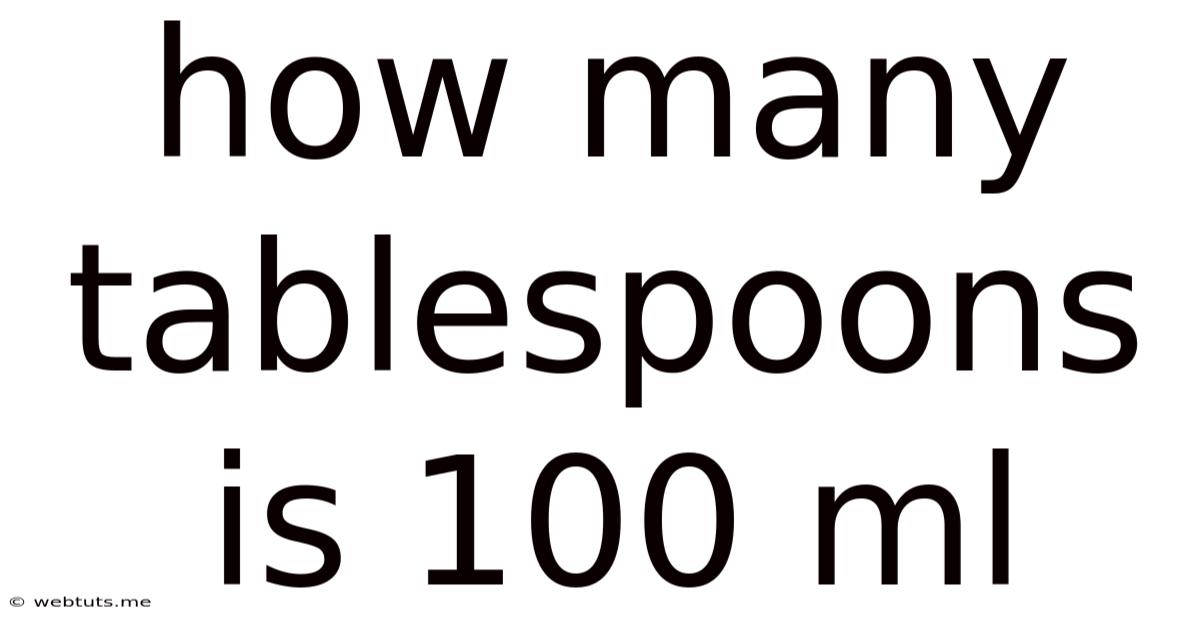How Many Tablespoons Is 100 Ml
Webtuts
May 12, 2025 · 4 min read

Table of Contents
How Many Tablespoons is 100ml? A Comprehensive Guide to Volume Conversions
Understanding volume conversions is crucial in various aspects of life, from cooking and baking to scientific experiments and medicine. One common conversion that often causes confusion is determining how many tablespoons are in 100ml. This comprehensive guide will not only answer that question but will delve deeper into the nuances of volume conversions, providing you with the tools and knowledge to confidently navigate similar conversions in the future.
Deciphering the Mystery: Tablespoons and Milliliters
Before we dive into the specific conversion of 100ml to tablespoons, let's establish a foundational understanding of the units involved:
Milliliters (ml): This is a unit of volume in the metric system. The metric system is based on powers of 10, making conversions relatively straightforward. A milliliter is one-thousandth of a liter. It's a commonly used unit for measuring liquids, particularly in cooking, medicine, and science.
Tablespoons (tbsp or T): This is a unit of volume in the imperial system, primarily used in cooking and baking. The size of a tablespoon can vary slightly depending on the measuring utensil used, but a standard tablespoon is generally considered to be approximately 15 milliliters. This is where the complexity in conversions arises, as the exact volume can fluctuate.
The Conversion: 100ml to Tablespoons
The most common and widely accepted conversion factor is that 1 tablespoon (tbsp) is approximately equal to 15 milliliters (ml).
Therefore, to convert 100ml to tablespoons, we perform the following calculation:
100 ml / 15 ml/tbsp ≈ 6.67 tbsp
This means that 100ml is approximately equal to 6.67 tablespoons. However, it's crucial to remember that this is an approximation. The actual number of tablespoons might vary slightly depending on the accuracy of your measuring tools.
Factors Affecting Accuracy in Volume Conversions
Several factors can influence the precision of volume conversions, particularly when dealing with less precise measuring tools:
-
Measuring Utensil Variation: Tablespoons in different measuring sets can vary in size. Some might be slightly larger or smaller than the standard 15ml. Using a consistently calibrated measuring set is vital for accurate results.
-
Liquid Viscosity: The thickness or viscosity of the liquid being measured can affect the volume. Thicker liquids, like honey or syrup, might not fill a tablespoon to the same level as a thinner liquid, like water.
-
Meniscus: When measuring liquids, the surface of the liquid forms a curve called a meniscus. Accurate measurement requires reading the volume at the bottom of the meniscus. Inconsistent meniscus reading can lead to inaccuracies.
Beyond the Basic Conversion: A Deeper Dive into Volume Units
Understanding the relationship between milliliters and tablespoons is just the beginning. To become truly proficient in volume conversions, it's essential to expand your knowledge to include other common units:
-
Teaspoons (tsp or t): A standard teaspoon is approximately 5ml. This relationship is crucial for converting between tablespoons and teaspoons (1 tbsp ≈ 3 tsp).
-
Fluid Ounces (fl oz): This is another common unit in the imperial system. 1 fluid ounce is approximately equal to 30ml.
-
Cups: A standard cup is typically 8 fluid ounces, or approximately 240ml.
-
Liters (L): The base unit of volume in the metric system, 1 liter is equal to 1000 ml.
Practical Applications of Volume Conversions
Accurate volume conversions are critical in a wide range of applications:
-
Cooking and Baking: Precise measurements are key to achieving consistent results in culinary endeavors. Converting between metric and imperial units allows cooks to use recipes from diverse sources.
-
Medicine: Accurate dosage in medicine is paramount. Converting volumes ensures the correct amount of medication is administered.
-
Science and Research: Scientific experiments often require precise measurements of liquids. Accurate conversions are crucial for reliable and reproducible results.
-
DIY Projects: Many DIY projects, from crafting to home repairs, involve measuring liquids. Accurate conversions help ensure the project's success.
Tips for Accurate Volume Measurement
-
Use calibrated measuring tools: Invest in a good set of measuring spoons and cups that are accurately calibrated.
-
Read the measurements at eye level: Ensure you are reading the measurement at the bottom of the meniscus for accurate readings.
-
Level the spoon or cup: Ensure the measuring tool is level to prevent inaccurate readings due to tilting.
-
Use the correct conversion factor: Always use the most accurate conversion factor for the specific units you're working with.
-
Double-check your calculations: It's always a good idea to double-check your calculations to minimize errors.
Mastering Volume Conversions: A Skill for Life
The ability to accurately convert between different units of volume is a valuable life skill applicable across various domains. While the conversion of 100ml to tablespoons, approximating to 6.67 tbsp, provides a practical answer, the underlying principles of volume measurement and conversion are far more significant. Understanding the nuances, potential inaccuracies, and the broader context of different volume units empowers you to handle similar conversions with confidence and precision, leading to more successful outcomes in your cooking, experiments, and daily life. Remember, practice makes perfect! The more you practice these conversions, the more comfortable and accurate you will become.
Latest Posts
Latest Posts
-
400 Mg Is How Many Ounces
May 12, 2025
-
30 Days From February 1 2024
May 12, 2025
-
How Many Seconds In 5 Mins
May 12, 2025
-
How Many Hours Is 131 Minutes
May 12, 2025
-
55 Mph To Feet Per Second
May 12, 2025
Related Post
Thank you for visiting our website which covers about How Many Tablespoons Is 100 Ml . We hope the information provided has been useful to you. Feel free to contact us if you have any questions or need further assistance. See you next time and don't miss to bookmark.